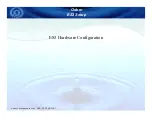
11-13
IM 2553A-01EN
11-13
IM 2553A-01EN
3
2
1
4
5
6
7
8
9
10
11
12
13
14
App
Index
Commands
11.7 Common Command Group
The commands in this group are defined in IEEE 488.2-1992 and are independent from the instrument’s individual
functions. There are no front panel dials and switches that correspond to the commands in this group.
*CLS
Function
Clears the standard event register, extended
event register, and error queue.
Syntax
*CLS
Example
*CLS
Description • If the *CLS command is located immediately
after the program message terminator, the
output queue is also cleared.
• For information about each register and queue,
see chapter 12, “Status Reports.”
*ESE
Function
Sets or queries the standard event enable
register.
Syntax
*ESE {<NRf>}
*ESE?
<NRf> = 0 to 255
Example
*ESE 251
*ESE? -> 251
Description • Specify the value as a sum of the values of
each bit in decimal format.
• For example, specifying *ESE 251 will cause
the standard enable register to be set to
11111011.
In this case, bit 2 of the standard event register
is disabled. This means that bit 5 (ESB) of the
status byte register is not set to 1, even if a
query error occurs.
• The default value is *ESE 0 (all bits disabled).
• A query using *ESE? will not clear the contents
of the standard event enable register.
• For information about the standard event
enable register, see section 12.1.
*ESR?
Function
Queries and clears the standard event register.
Syntax
*ESR?
Example
*ESR? -> 32
Description • A sum of the values of each bit is returned in
decimal format.
• When an SRQ is sent, you can check what
types of events have occurred.
• For example, if a value of 32 is returned, this
indicates that the standard event register is set
to 00100000.
This means that the SRQ occurred due to a
command syntax error.
• A query using *ESR? will clear the contents of
the Standard Event Register.
• For information about the standard event
register, see section 12.3.
*IDN?
Function
Queries the instrument model.
Syntax
*IDN?
Example
*IDN?
-> YOKOGAWA,2553A,123456789,1.01
Description • The information is returned in this form:
<manufacture>, <model>, <serial number>,
<firmware version>.
• For details on the model, see “Checking the
Package Contents.”
*OPC
Function
Sets bit 0 (the OPC bit) of the standard event
register to 1 upon the completion of the specified
overlap command.
Syntax
*OPC
Example
*OPC
Description The 2553A does not have overlap commands.
The OPC bit is always set to 1.
*OPC?
Function
Returns ASCII code 1 when the specified overlap
command is completed.
Syntax
*OPC?
Example
*OPC? -> 1
Description The 2553A does not have overlap commands. 1
is always returned.
*OPT?
Function
Queries the installed options.
Syntax
*OPT?
Example
*OPT? -> NONE
Description The command returns the presence or absence
of options. Because the 2553A does not have
any options, “NONE” is always returned. The
*OPT? query must be the last query of a program
message. An error occurs if there is a query after
this query.
*RST
Function
Initializes settings.
Syntax
*RST
Example
*RST
Description All settings except communication settings are
reset to their factory default values.
For the default values, see appendix 5.
















































